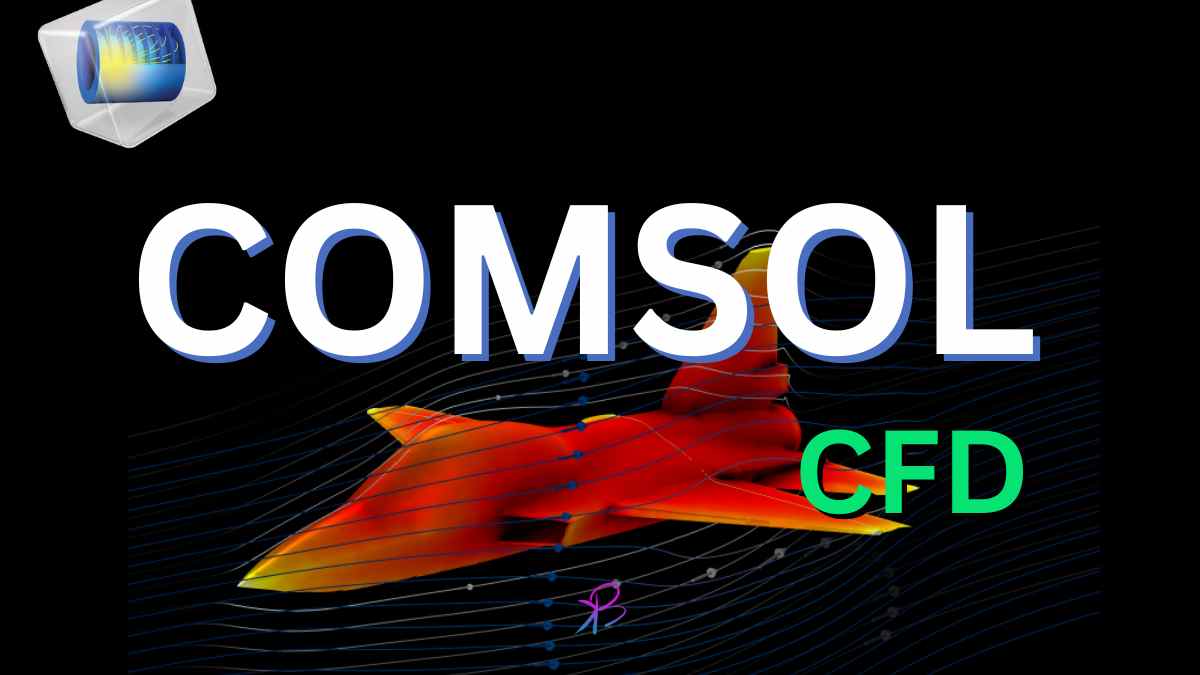Introduction to CFD Simulation in COMSOL Multiphysics
In recent years, CFD simulation has become an essential tool for engineers and researchers to analyze and optimize complex fluid flow and heat transfer problems. One of the leading software packages for CFD simulation is COMSOL Multiphysics, a versatile platform that integrates physics-based modeling, simulation, and analysis. In this article, we will read about the process of conducting a CFD simulation in COMSOL Multiphysics and learn about its various applications. Official CFD page LINK.
Watch free YouTube tutorials in COMSOL
Fundamentals of CFD in COMSOL Multiphysics
To better understand CFD simulations in COMSOL, it is crucial to grasp the basic principles behind the process. CFD, or Computational Fluid Dynamics, involves the use of numerical methods and algorithms to solve and analyze fluid flow problems. COMSOL Multiphysics employs the Finite Element Method (FEM), a powerful numerical technique for solving partial differential equations (PDEs) that govern fluid dynamics, heat transfer, and other physical phenomena.
Setting Up a CFD Simulation in COMSOL Multiphysics
Performing a CFD simulation in COMSOL Multiphysics involves several steps, which we outline below:
- Geometry Creation: The first step is to create a geometric representation of the problem domain. This can be done using COMSOL's built-in geometry tools or by importing a CAD model.
- Defining the Physics: Next, select the appropriate physics interfaces for your simulation, such as laminar or turbulent flow, heat transfer, or multiphase flow.
- Mesh Generation: Generate a finite element mesh for the problem domain. COMSOL provides various meshing options, including automatic mesh generation and manual control over mesh density and element size.
- Boundary Conditions and Material Properties: Define boundary conditions and assign material properties to the model. These inputs are critical to the accuracy of the simulation results.
- Solving the Problem: Run the simulation and solve the governing PDEs. COMSOL offers multiple solvers and iterative methods to efficiently solve complex problems.
- Post-processing and Analysis: Visualize and analyze the simulation results using COMSOL's post-processing tools, such as contour plots, streamline plots, and particle tracing.

Advanced Techniques and Applications of CFD in COMSOL Multiphysics
COMSOL Multiphysics offers various advanced techniques and modules for specialized CFD applications. Some of these include:
- Turbulence Modeling: COMSOL supports various turbulence models, including k-ε, k-ω, and Large Eddy Simulation (LES), enabling accurate simulations of turbulent flows.
- Multiphase Flow: The multiphase flow module allows for the simulation of complex flows involving multiple immiscible fluids, such as liquid-liquid or gas-liquid systems.
- Heat Transfer: COMSOL's heat transfer module enables the analysis of conjugate heat transfer, accounting for both fluid flow and solid heat conduction.
- Fluid-Structure Interaction (FSI): The FSI module couples fluid flow with structural mechanics, allowing for the study of deformable structures and their interaction with fluids.
Optimizing CFD Simulations in COMSOL Multiphysics
To ensure accurate and efficient CFD simulations, it is essential to optimize various aspects of the simulation process. Some key considerations include:
- Mesh Quality: A high-quality mesh ensures accurate results and faster convergence. Experiment with different meshing strategies and refine the mesh in critical areas.
- Boundary Conditions: Choose appropriate boundary conditions and validate them with experimental data or analytical solutions, if available.
- Solver Selection: Opt for the most suitable solver for your specific problem. COMSOL offers direct solvers, such as the MUMPS solver, and iterative solvers, like the GMRES and BiCGStab methods. Choose a solver based on problem size, complexity, and available computational resources.
- Model Simplification: Simplify your model when possible, while retaining essential physics. This can lead to faster simulations without compromising the accuracy of the results.
- Parallel Processing: Leverage COMSOL's parallel processing capabilities to speed up large-scale simulations. COMSOL supports both shared-memory and distributed-memory parallelism.

Case Studies: Real-World Applications of CFD in COMSOL Multiphysics
To illustrate the practical applications of CFD simulations in COMSOL Multiphysics, let's explore a few real-world examples:
- Aerospace Industry: CFD simulations are widely used in the aerospace industry to study the aerodynamics of aircraft and spacecraft. Engineers can optimize wing shapes, analyze lift and drag forces, and assess the impact of turbulence on flight performance.
- Automotive Industry: In the automotive sector, CFD simulations help optimize vehicle design for improved fuel efficiency and reduced emissions. Engineers can analyze airflows around the vehicle, optimize heat management in engines, and design efficient cooling systems for batteries and electronics.
- Environmental Engineering: COMSOL Multiphysics can be used to simulate pollutant dispersion in the atmosphere, study the hydrodynamics of rivers and oceans, and design efficient wastewater treatment processes.
- Biomedical Applications: CFD simulations can model blood flow in the cardiovascular system, optimize the design of medical devices, and study the transport of drugs in the body.
CFD simulations in COMSOL Multiphysics offer a powerful and versatile tool for analyzing complex fluid flow and heat transfer problems. By following best practices in setting up, solving, and optimizing CFD simulations, engineers and researchers can gain valuable insights, develop innovative solutions, and make data-driven decisions to improve the performance of their designs.
Official COMSOL Resources can be found at comsol.com
For help in modelling in any FEA, FDTD, DFT Simulation / Modelling work, you can contact us (bkcademy.in@gmail.com) or in any platform.
Interested to Learn Engineering modelling? Check our Courses?
u can follow us on social media
Share the resource
-.-.-.-.-.-.-.-.-.().-.-.-.-.-.-.-.-.-
© bkacademy

One reply on “CFD Simulation in COMSOL Multiphysics”
[…] Avoidance Analysis: This involves simulating the ISS’s path to ensure it avoids other satellites and space debris during its descent. Advanced […]